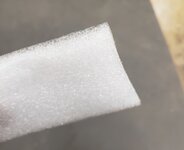vavavallay
Member
Hey folks! My name is Ilyssa - I am new to turning and this is my 7th pen. I was hoping my first post could be to show off a pen... however I have been running into a repeated issue since the 3rd pen or so: I am getting white cloudy spots in the same spots consistently, seems to be always around the edges close to the bushings and even a bit further into the pen from there. I always notice it right before or immediately after starting micromesh (see photos below)
My basic protocol is to add 1-2 layers of thin CA, then 5-7 layers of medium CA. I use skew to clean up high spots, sand with Abranet 400 grit until 90% shiny spots gone (lathe on), sand longitudinally to remove circular sanding marks until all clear spots gone, spray with alcohol and wipe down, start micromesh from 1500-12000.
I am using StickFast thin and Medium. I am not using white/normal paper towels.
Here is how I have tried to mitigate:
1a. Sanding all the way back down to the wood and restarting the CA process. This gives similar results
1b. Sanding down until I can no longer see the white spot and recoating with a few layers CA, and clean up with skew and sanding down to 400 grit again. This seems to make the issue actually worse.
2. Using less Activator spray.
3. Slowing the lathe speed down to ~600 for sanding and CA application. This seems to help distribute glue more evenly but nothing more.
4. Increasing the ratio of Thin:Thick layers (went from 1:8 to 2:6). Didn't notice a difference here.
5. Using a small poly bag to spread the wax instead of blue shop towels. This makes each layer thicker (Less absorbent), but still didn't help.
6. Taking longer times in between each layer (~3 minutes). Can't tell if this helped or not.
So far nothing gives... It almost seems to be happening more frequently with each pen - I have altogether thrown away some blanks cause I wasn't able to fix after 3 rounds of CA application.
I thought this may be from over sanding (I tend to get aggressive to get the circular scratches out in the last steps), but I have been careful not to do that and am still seeing this issue. Not sure where to go from here and hoping someone can provide a tip or insight to try!
Thank you so much ahead of time and sorry if this has been discussed before - some of the ideas I tried came from reading other posts about this. Let me know if I've missed something! Hope to contribute more to these forums in the future.





My basic protocol is to add 1-2 layers of thin CA, then 5-7 layers of medium CA. I use skew to clean up high spots, sand with Abranet 400 grit until 90% shiny spots gone (lathe on), sand longitudinally to remove circular sanding marks until all clear spots gone, spray with alcohol and wipe down, start micromesh from 1500-12000.
I am using StickFast thin and Medium. I am not using white/normal paper towels.
Here is how I have tried to mitigate:
1a. Sanding all the way back down to the wood and restarting the CA process. This gives similar results
1b. Sanding down until I can no longer see the white spot and recoating with a few layers CA, and clean up with skew and sanding down to 400 grit again. This seems to make the issue actually worse.
2. Using less Activator spray.
3. Slowing the lathe speed down to ~600 for sanding and CA application. This seems to help distribute glue more evenly but nothing more.
4. Increasing the ratio of Thin:Thick layers (went from 1:8 to 2:6). Didn't notice a difference here.
5. Using a small poly bag to spread the wax instead of blue shop towels. This makes each layer thicker (Less absorbent), but still didn't help.
6. Taking longer times in between each layer (~3 minutes). Can't tell if this helped or not.
So far nothing gives... It almost seems to be happening more frequently with each pen - I have altogether thrown away some blanks cause I wasn't able to fix after 3 rounds of CA application.
I thought this may be from over sanding (I tend to get aggressive to get the circular scratches out in the last steps), but I have been careful not to do that and am still seeing this issue. Not sure where to go from here and hoping someone can provide a tip or insight to try!
Thank you so much ahead of time and sorry if this has been discussed before - some of the ideas I tried came from reading other posts about this. Let me know if I've missed something! Hope to contribute more to these forums in the future.

